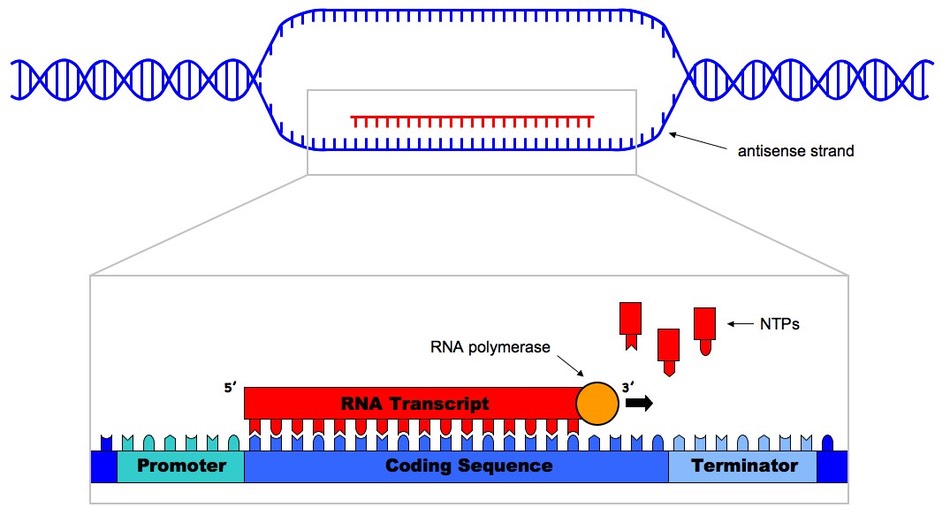7.3.1 State that transcription is carried out in a 5' - 3' direction
Transcription is carried out in a 5' - 3' direction (of the new RNA strand)
7.3.2 Distinguish between the sense and antisense strands of DNA
DNA consists of two polynucleotide strands, only one of which is transcribed into RNA
- The antisense strand is transcribed into RNA
- Its sequence will be complementary to the RNA sequence and will be the "DNA version" of the tRNA anticodon sequence
- The sense strand is not transcribed into RNA
- Its sequence will be the "DNA version" of the RNA sequence (identical except for T instead of U)
7.3.3 Explain the process of transcription in prokaryotes, including the role of the promoter region, RNA polymerase, nucleoside triphosphates and the terminator
A gene is a sequence of DNA which is transcribed into RNA and contain three main parts:
- Promoter: Responsible for the initiation of transcription (in prokaryotes, a number of genes may be regulated by a single promoter - this is an operon)
- Coding Sequence: The sequence of DNA that is actually transcribed (may contain introns in eukaryotes)
- Terminator: Sequence that serves to terminate transcription (mechanism of termination differs between prokaryotes and eukaryotes)
Transcription is the process by which a DNA sequence (gene) is copied into a complementary RNA sequence and involves a number of steps:
- RNA polymerase binds to the promoter and causes the unwinding and separation of the DNA strands
- Nucleoside triphosphates (NTPs) bind to their complementary bases on the antisense strand (uracil pairs with adenine, cytosine pairs with guanine)
- RNA polymerase covalently binds the NTPs together in a reaction that involves the release of two phosphates to gain the required energy
- RNA polymerase synthesises an RNA strand in a 5' - 3' direction until it reaches the terminator
- At the terminator, RNA polymerase and the newly formed RNA strand both detach from the antisense template, and the DNA rewinds
- Many RNA polymerase enzymes can transcribe a DNA sequence sequentially, producing a large number of transcripts
- Post-transcriptional modification is necessary in eukaryotes
Overview of Transcription

7.3.4 State that eukaryotic RNA needs the removal of introns to form mature mRNA
- Euakaryotic genes may contain non-coding sequences called introns that need to be removed before mature mRNA is formed
- The process by which introns are removed is called splicing
- The removal of exons (alternative splicing) can generate different mRNA transcripts (and different polypeptides) from a single gene
![]() Splicing
Splicing